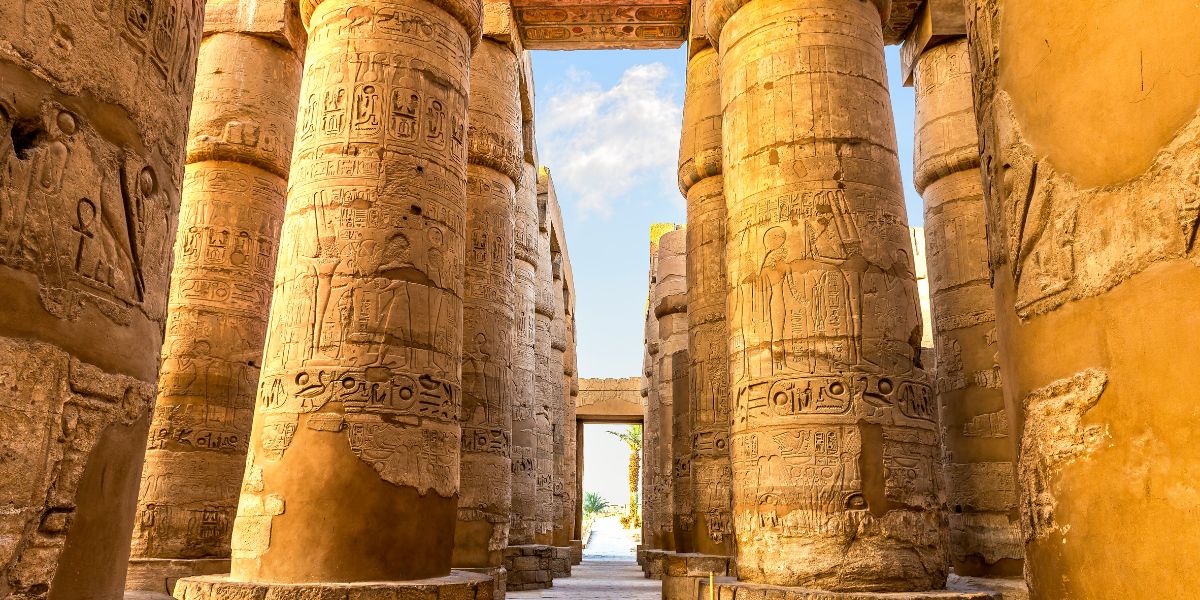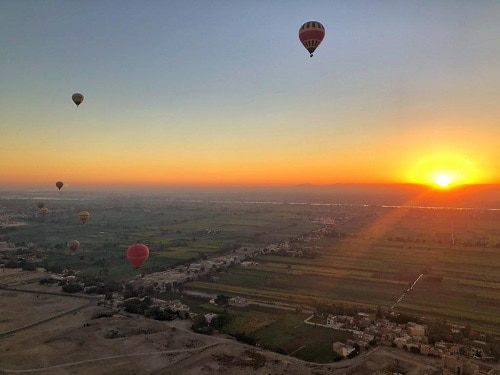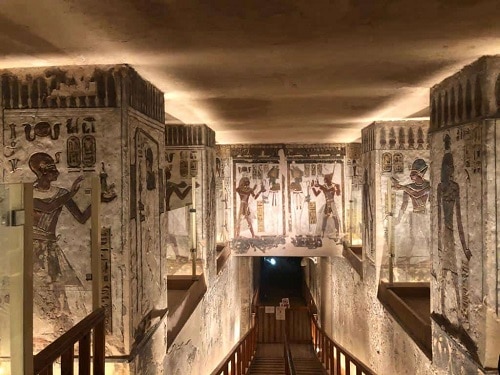Best Things to Do in Luxor Egypt This Year
Giza’s famous pyramids may be the first thing that comes to mind when people think of Egypt. Or maybe sailing down the majestic Nile River in a luxurious yet understated cruise vessel. But what about Luxor?
Many visitors deem Luxor as a quick base before hopping aboard one of those aforementioned cruises, but it’s so much more. Whether you cruise or not, plan to spend some time in this magical city alive with the Nile’s electric energy. From admiring the tombs of ancient kings to exploring the mummification museum or viewing the sunrise over the Nile River from a hot air balloon, here are some of the best things to do in Luxor.
- Best Things to Do in Luxor Egypt This Year
- Getting to Luxor
- Where to Stay in Luxor
- Full-Day Tours & Guided Luxor Experiences
- Take a Nile River Felucca Ride
- Visit Karnak Complex
- Hop in a Hot Air Balloon
- Visit the Mummification Museum
- Explore Valley of the Kings
- Eat Egyptian Food
- Admire the Temple of Hatshepsut
- Head to Dendera
- Gaze at the Colossi of Memnon
- Visit the Luxor Temple
- Stroll through the Luxor Museum
- Explore the Tombs of the Nobles
- Wander through the Valley of the Queens
- Visit Medinet Habu, the Mortuary Temple of Ramesses III
- Explore Deir el-Medina, the Workers' Village
- Take a Horse Carriage Ride through Luxor Town
- Visit the Ramesseum, the Memorial Temple of Ramesses II
- Shop at the Local Luxor Market for Souvenirs
- Take a Sunset Nile Cruise on a Traditional Dahabiya
- Explore the Temple of Seti I in Qurna
- Frequently Asked Questions about Visiting Luxor
Getting to Luxor
Arrive in Luxor via a one-hour flight from Cairo on an airline like Egyptair. Those with time to spare can take the train for a more nostalgic, ten-hour journey through the Egyptian desert.
Where to Stay in Luxor
The Hilton Luxor sits on the banks of the Nile River’s East Bank. Make sure to ask for a riverside room in order to further enhance your Luxor experience.
Full-Day Tours & Guided Luxor Experiences
Depending on your travel plans, you may opt for a guided tour of Luxor, especially if it’s your first time visiting Egypt. These are surprisingly affordable, and Luxor Travels offers private day tours with visits to all of the top sites, including a guide.
If you’d prefer to navigate Luxor on your own, we include advanced ticketing options, and tours for specific attractions for all of the top experiences in the area below.
Winetraveler Tip: The wine industry is small in Egypt (they even import in grapes from Lebanon in some cases). While most restaurants won’t serve booze, you can usually order wine in your hotel. Ask if they have any Egyptian wine, and if not, you’ll likely end up with something French. Buying wine in duty-free is another way to ensure you’ll get your nightly glass (or bottle — no judgment here at Winetraveler — in).
Take a Nile River Felucca Ride
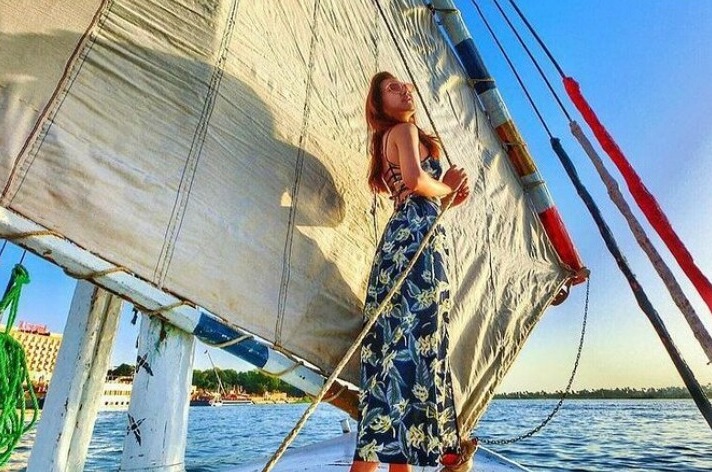
Even if you do have a Nile River cruise on your Egypt itinerary, there’s nothing like gliding along this mystical body of water in an Egyptian sailboat: a felucca. These one-to-two-hour sailboat rides are usually done around sunset so you can relax and watch the sun dip below the banks of the Nile as you sip mint tea. The rides are very affordable, so you can arrange for a private felucca cruise if you prefer.
Visit Karnak Complex
This massive temple complex on the Nile’s East Bank (once known as Thebes) covers over 100 hectares. Larger than many ancient cities, the Karnak complex is home to ruins of chapels, pylons, temples, obelisks and more. If you want to make just a quick visit, make sure to start with the main temple Amun. There’s also an evening light and sound show if you’d prefer to avoid the daytime’s searing hot temperatures. Private tours of the complex can also be arranged through Golden Jay Travel.
Hop in a Hot Air Balloon
Cruise high in the sky above sites like the Valley of the Kings, the Nile River and various ancient ruins in Luxor. Although this activity involves a 4:00 am wake up call, it’s worth it to go at sunrise. Seeing the landscape bathed in the yellow and orange hues of the rising sun from above is simply unforgettable.
Book an unforgettable balloon experience ahead of time with Egypt Tours Travel.
Visit the Mummification Museum
While most of Egypt’s most famous mummies now live in Cairo’s Egyptian Museum, you can learn about the mummification process at the Mummification Museum. Since ancient Egyptians mummified animals too, you’ll have the chance to view some interesting non-human mummies on display too. Book tickets ahead of time or check out these other guided options of the Mummification Museum via TripAdvisor.
Explore Valley of the Kings
One of Egypt’s most famed attractions, this rocky valley is home to a number of tombs of ancient pharaohs and nobles. Although most of the mummies are now in Cairo’s famous Egyptian museum, visitors can still explore the cave-like tombs, accompanied by an Egyptologist, including Tutankhamun’s final resting place.
Eat Egyptian Food
Sampling Egyptian delights is a must when in Luxor. Order hot or cold mezze dishes like hummus and koshari (a mixture of lentils, chickpeas, spices and more) as well as main dishes full of ingredients like coriander, aubergine, lamb and super green Molokhia.
Winetraveler recommends the restaurant Sofra. It’s affordable, with a relaxing, Egyptian-inspired terrace, delicious food and friendly service. Although Sofra doesn’t serve alcohol, you can always indulge in some wine back at the hotel.
RELATED: Detailed 10 Day Itinerary For Visiting Egypt
Admire the Temple of Hatshepsut

The three-tiered Mortuary Temple of Hatshepsut bakes under the sunlight, so arrive early to visit this monument dedicated to Egypt’s famous female pharaoh, Hatshepsut. Parts of the temple were created to be illuminated with sunlight on specific days of the year, so if you can visit during the winter solstice, you’ll gain an extra ‘glowing’ perspective.
Head to Dendera
One of the best-preserved temples in Egypt, Dendera is located about an hour outside of Luxor. It’s worth the trip, though, as you can visit almost every single part of the complex, including some of the crypts and temple roofs. The largest and most impressive is the Temple of Hathor, dedicated to the Egyptian goddess of women, fertility and love. There are a range of private and group tours of Dendera that leave from Luxor and also include Abydos.
Gaze at the Colossi of Memnon
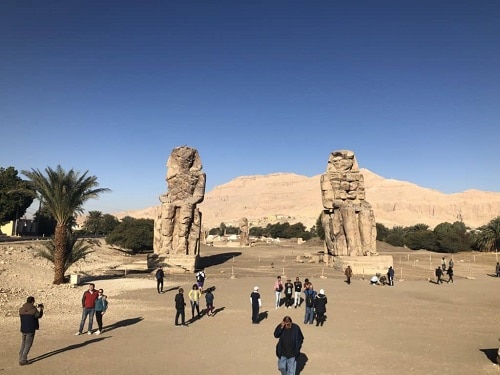
The absolutely massive statues of Memnon date back to the Dynasty XVIII. Besides snapping selfies with the impressive figures, listen carefully. They’ve been reported to make strange sounds on occasion. Although this is allegedly due to wind flowing through cracks in the statue’s rock after various earthquakes, you can decide what you believe after seeing (and possibly hearing) these extraordinary structures up close.
Visit the Luxor Temple
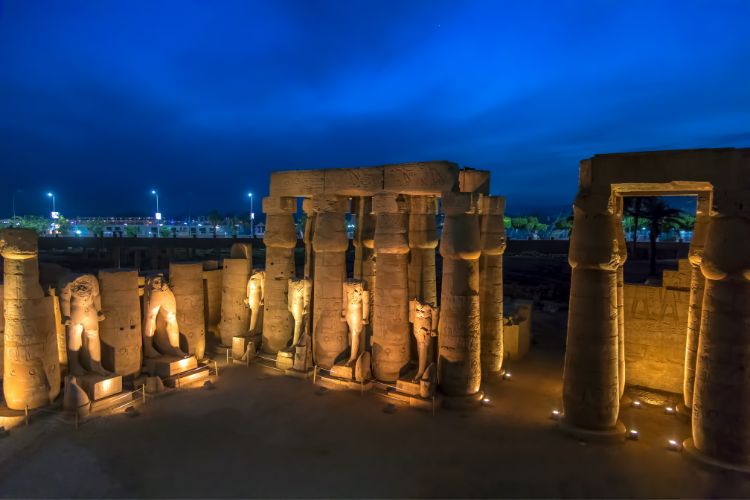
The Luxor Temple, constructed in 1400 BCE, is a monumental tribute to the ingenuity and artistic talent of ancient Egypt. Built primarily by Pharaoh Amenhotep III and later completed by Tutankhamun and Horemheb, it has been further added to by Ramses II, who erected a grand courtyard and colossal statues of himself. The temple complex, which served as a place of worship for Christians and then Muslims, still houses an active mosque today. When you visit, be sure to explore the vast array of structures including tall colonnades, large courts, and intricate reliefs depicting ancient religious rituals and significant historical events.
Stroll through the Luxor Museum
Housed in a contemporary building overlooking the Nile, the Luxor Museum provides an insightful look into the rich history and culture of ancient Thebes, now known as Luxor. Its extensive collection of antiquities includes artifacts from the nearby Valley of the Kings and Valley of the Queens, such as sculptures, jewelry, pottery, and statues of gods and pharaohs. The museum also displays a collection of items found in the Luxor Temple, including a calcite double statue of the crocodile god Sobek and the 18th Dynasty pharaoh Amenhotep III.
Explore the Tombs of the Nobles
Situated on the West Bank of the Nile, the Tombs of the Nobles is an ancient cemetery that houses the burial sites of high-ranking officials and artisans from the New Kingdom. Unlike the grandeur of royal tombs, these tombs provide a more realistic and detailed insight into daily life and death in ancient Egypt.
The tombs are adorned with vibrant and detailed frescoes illustrating scenes of agricultural activities, wildlife along the Nile, and religious ceremonies, providing visitors with a captivating glimpse into the past.
Wander through the Valley of the Queens
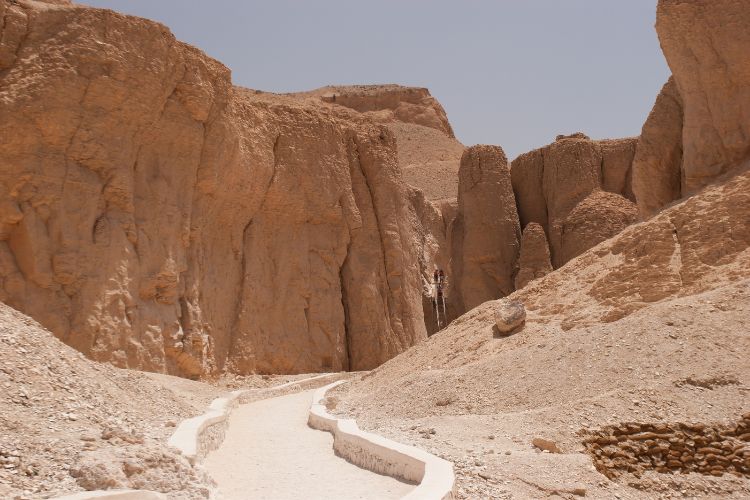
The Valley of the Queens is a necropolis where wives of Pharaohs were buried during the 19th and 20th dynasties. It contains about 75 tombs, most notably the tomb of Nefertari, the wife of Ramesses II. Although smaller and less frequented than the nearby Valley of the Kings, the Valley of the Queens offers its own unique and more intimate look into royal burial customs. Some tombs are open for public viewing and are adorned with intricate and well-preserved wall paintings depicting the queen’s journey to the afterlife.
Visit Medinet Habu, the Mortuary Temple of Ramesses III
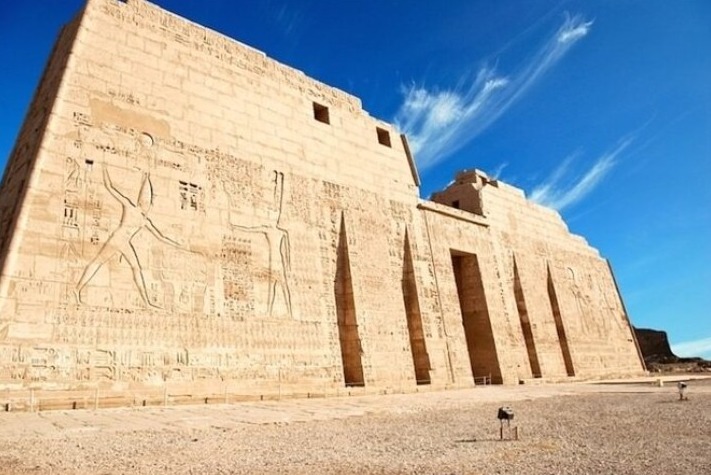
Medinet Habu is the mortuary temple of Ramesses III, the second Pharaoh of the Twentieth Dynasty. It’s one of the most well-preserved and impressive sites in Luxor. This vast complex is an architectural wonder, encompassing a royal palace, a chapel, administrative offices, and residential quarters. The walls of the temple are inscribed with detailed reliefs depicting military campaigns, religious ceremonies, and victory celebrations of Ramesses III, offering visitors a narrative of the king’s reign.
Explore Deir el-Medina, the Workers’ Village
Deir el-Medina, also known as the Valley of the Artisans, is a unique archaeological site that provides insights into the daily life of the workmen who constructed the royal tombs in the Valley of the Kings. This well-preserved village includes houses, tombs of the workers, and a temple dedicated to the goddess Hathor. Exploring this site offers a rare glimpse into the community of artisans and their families, and how they lived, worshipped, and were buried.
Take a Horse Carriage Ride through Luxor Town
One of the best ways to explore Luxor is by taking a traditional horse carriage ride around the city. These tours provide an authentic and relaxing way to navigate the busy streets, passing by bustling bazaars, aromatic food stalls, ancient temples, and the scenic Nile riverfront. A carriage ride offers a unique perspective on the city’s daily life and is an enjoyable way to observe the blend of ancient and modern cultures.
Visit the Ramesseum, the Memorial Temple of Ramesses II
The Ramesseum is the memorial temple of Pharaoh Ramesses II. Even though it is now partially in ruins, it was once a grand architectural masterpiece. The complex includes a large pylon, courtyards, a hypostyle hall, and numerous statues of the pharaoh. The most famous is a colossal granite statue of Ramesses II that once stood more than 60 feet tall.
Shop at the Local Luxor Market for Souvenirs
Luxor’s local market, also known as the souk, is a vibrant place to experience the local culture. Here, you’ll find a wide range of goods, from spices and fruits to textiles and handcrafted souvenirs. Haggling is part of the shopping experience, so don’t be afraid to negotiate prices. The market is also a great place to sample local cuisine, with numerous street food vendors offering traditional Egyptian dishes.
Take a Sunset Nile Cruise on a Traditional Dahabiya
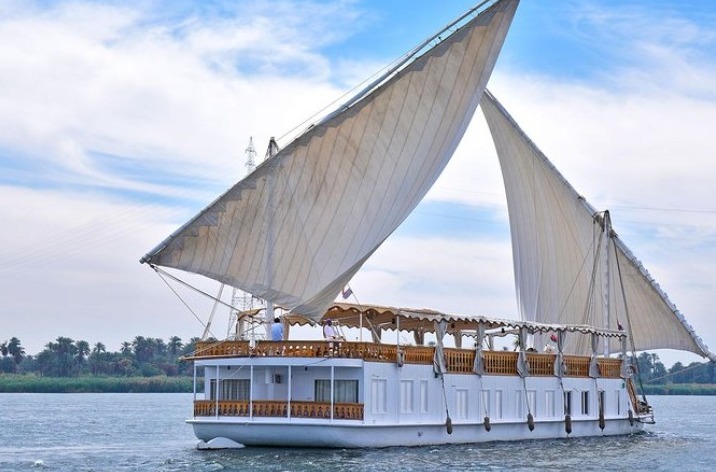
For a tranquil and picturesque experience, take a sunset or multi-day cruise on the Nile in a traditional Dahabiya, a larger wooden sailing boat compared to the Felucca. These leisurely cruises offer panoramic views of the river, flanked by lush palm groves and sand dunes. It’s a great opportunity to observe local life along the riverbanks and witness the sun setting over the Nile, painting the sky with vibrant hues. While more expensive, these can be exciting and immersive multi-day tour packages that handle all of the logistics for you.
Explore the Temple of Seti I in Qurna
The Temple of Seti I, located on the west bank of Luxor, is often overlooked by tourists but is a hidden gem. This temple, dedicated to the New Kingdom Pharaoh Seti I and his ancestors, is unique for its well-preserved reliefs and vibrant colors. Despite its location away from the main tourist areas, it provides a serene atmosphere and a captivating insight into the religious beliefs and practices of the ancient Egyptians.
Frequently Asked Questions about Visiting Luxor
You are reading “Best Things to Do in Luxor Egypt This Year”: Back To Top
what to do in Luxor, visiting Luxor, things to do near me, felucca ride in Luxor: Egypt itinerary
If you enjoyed this guide, consider joining the Facebook Group to interact with other Winetravelers and for wine travel inspiration around the world. Be sure to follow us on both Twitter and Instagram to stay up to date with our trending content.
